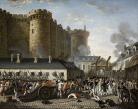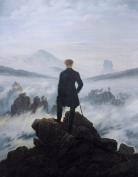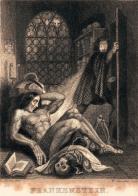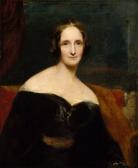Stacey Folsom Timeline for Frankenstein
Created by Stacey Folsom on Thu, 11/18/2021 - 14:43
Part of Group:
My timeline is going to focus on the novel Frankenstein by Mary Shelley and it's historical and cultural contextualization with movements like the French Revolution and Romanticism. I will also discuss certain events that occur during these movements and their relationship with Frankenstein.
Timeline
Chronological table
| Date | Event | Created by | Associated Places | |
|---|---|---|---|---|
| 14 Summer 1789 |
The French RevolutionThe French Revolution began with the storming of the Bastille on July 14, 1789. The primary reason for this occurrance was a financial crisis and widespread conflict with the French upper class, or Monarchy and the lower class. Population growth, economic depression, rising unemployment, and high food prices and taxes contributed to the revolt. Along with a government and ruling wealthy class unwilling to help resolve these issues. Notable ideals during this time was the pursuit of liberty, equality, and fraternity. The escalation of violence eventually led to the Reign of Terror, a period during the French Revolution that was marked by massacres and public executions. In Mary Shelley's Frankenstein, the creature is a representation of the lower class, and his desire for equality and acceptance by the people in his community. The creature wanting Victor to create a companion for him to share his life with as an equal. |
Stacey Folsom | ||
| 1791 |
GalvanismGalvanism, discovered in the 1780's, is the use of electric current attached to living and nonliving tissue. Named after Luigi Galvani, he observed the legs of dead frogs twitching when metals and alloys that were magnetic and electrically connected by an electrolyte came into contact with them. He thought the source of the electricity was produced by the frogs muscular and nervous sytems when in fact, it was from the electric current. The physicist, Alessandro Volta made this discovery. He concluded that the electricity originated from the metals copper and zinc. He eventually created the battery cell. Mary Shelley believed that it could be possible for the dead to reanimated with electricity, "Perhaps a corpse would be reanimated; galvanism had given a token of such things; perhaps the component parts of a creature might be manufactured, brought together, and enduced with vital warmth" (Shelley 1831 Introduction). https://library.si.edu/exhibition/fantastic-worlds/body-electric |
Stacey Folsom | ||
| 1817 |
RomanticismRomanticism was a literary movement in Europe late 18th century. It was a revoluntionary movement that radically changed how artists understood their works, placing emphasis on nature, imagination, emotions (fear, horror, terror). There was a rise of the liberal movement and radical ideas. The people's struggle for equality and freedom. There were also events and ideologies of the French Revolution that were a factor because many Romantics were cultural revolutionaries and sympathetic to the cause. Romanticism promoted imagination and creativity for everyone. Mary Shelley used very descriptive language in her novel Frankenstein. She described beautiful, mysterious landscapes and scenery. Victor Frankestein and the creature were consumed with emotion and in constant pursuit of happiness. https://www.theartstory.org/movement/romanticism/ https://commons.wikimedia.org/wiki/File:Caspar_David_Friedrich_-_Wanderer_above_the_sea_of_fog.jpg |
Stacey Folsom | ||
| 1831 |
The GothicThe Gothic was a literary movement that put focus on ruin, decay, terror, and chaos. It was developed during the Romantic period and was a response to rational thought and reason. It is meant to emphasize human emotions, instead of reasoning. The readers imagination is stoked with dark scenery and obscurity. It will often center around an old house inhabited by ghosts or family curses. Key elements that are most always used are: atmosphere which focuses on fear of the unexplained, settings removed from civilization, the paranormal or supernatural, terror, omens, and a lady in distress. In gothic literature, the sublime brings in aspects of humanity. It produces the "strongest emotion which the mind is capable of feeling" (Edward Burke On the Sublime 1757). Disruption of harmony is evoked by terror and to cause terror, you need obscurity. Mary Shelley brings the supernatural and gothic into her novel Frankenstein. Victor's creature was made from death and decay, then brought to life by electricity. Victor used nature to create something unnatural. https://www.thoughtco.com/gothic-literature-2207825 https://the-artifice.com/the-sublimes-effects-in-gothic-fiction/ https://natureofwriting.com/courses/literary-theory-1/lessons/edmund-burke/topic/the-sublime https://en.wikipedia.org/wiki/Frankenstein#/media/File:Frontispiece_to_Frankenstein_1831.jpg |
Stacey Folsom | ||
| 1840 |
Mary ShelleyMary Shelley was born August 30, 1797 in London, England. Mary's mother died a few days after she was born, so she was raised and educated by her father. Out of the seven novels that she wrote, Frankenstein is the most well known and is still regarded today as one of the best novels ever written. It was written at Lake Geneva in the summer of 1816, while on a trip with her husband and friends. They were writing and telling ghost stories to each other just for fun. There was casual conversation among them about reanimation of the dead. This was a time of enlightenment and scientific revolution. Many of these thinkers were well versed in advancement in science and placed value in rational thought. Mary's novel challenges this and emphasizes that humanity is more important than scientific progression. https://www.biography.com/writer/mary-shelley https://commons.wikimedia.org/wiki/File:Mary_Wollstonecraft_Shelley_Rothwell.tif |
Stacey Folsom |





